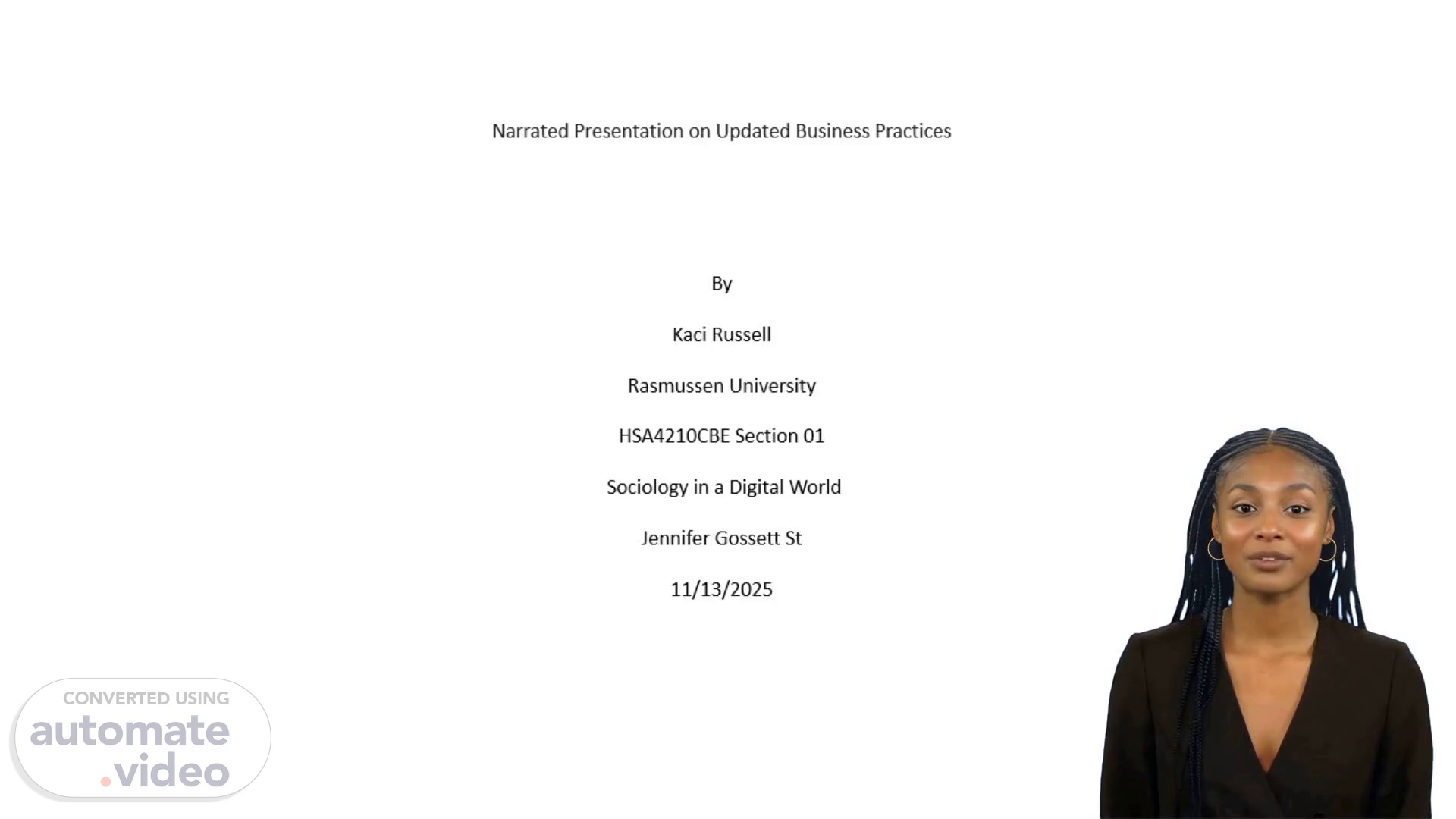
Narrated Presentation on Updated Business Practices By Kaci Russell Rasmussen University HSA4210CBE Section 01 Sociology in a Digital World Jennifer Gossett St 11/13/2025
Scene 1 (0s)
[Virtual Presenter] Narrated Presentation on Updated Business Practices By Kaci Russell Rasmussen University HSA4210CBE Section 01 Sociology in a Digital World Jennifer Gossett St 11/13/2025.
Scene 2 (22s)
[Audio] Digital and Technological Growth in Organizations Definition of Digital Growth Digital growth refers to the expansion and enhancement of an organization's capabilities through the adoption of digital technologies. This includes the integration of digital tools, platforms, and processes to improve efficiency, customer engagement, and overall business performance. Impact of Digital Growth on Organizations Increased Efficiency: Automation of processes reduces manual work and errors. Enhanced Customer Experience: Digital tools allow for personalized services and improved communication. Market Reach: Digital platforms enable businesses to reach a global audience. Impact of Digital Growth on Society and Your Store Societal Changes: Digital growth fosters innovation, creates jobs, and enhances connectivity. Future of Your Store: Embracing digital tools can lead to improved inventory management, better customer insights, and increased sales. Start by defining digital growth clearly. Emphasize its dual influence on both organizations and society. Illustrate with examples familiar to the audience, such as mobile shopping apps or social media marketing. Highlight how even traditional, local stores must adapt by embracing technology for continued relevance and competitiveness..
Scene 3 (1m 55s)
[Audio] Individual and Organizational Digital Identity Key Methods of Identity Development Social Media Presence: Individuals can shape their identity through curated online profiles. Professional Networking: Platforms like LinkedIn help in building a professional identity. Content Creation: Blogging or vlogging can establish expertise and personal branding. Technology and Identity Formation Digital Forums: Online communities allow individuals to express their identities and connect with like minded people. Organizational Identity: Employees' digital identities contribute to the overall brand image of the organization. Role of Individuals in Organizational Identity Employees represent the organization’s values and culture through their actions and online presence. Collective employee identities can enhance or detract from the organizational brand. Explain how digital identities are carefully crafted and the consequences they carry. Use relatable examples such as social media profiles or online reviews. Transition to organizations by describing how digital identity impacts brand perception. Highlight the important role technology platforms play in shaping both individual and organizational identities..
Scene 4 (3m 26s)
[Audio] Challenges and Benefits of Upgrading Technological Resources Sociological Theories on Access to Technology Social Capital Theory: Access to technology can enhance social networks and opportunities. Resource Dependency Theory: Organizations depend on external resources, including technology, for survival and growth. Societal Changes Due to Technology E-commerce Growth: Shift from physical stores to online shopping. Remote Work: Increased flexibility and changes in workplace dynamics. Digital Divide The digital divide refers to the gap between those with easy access to digital technology and those without. This can impact your store by limiting customer engagement and sales opportunities. Discuss both sides of upgrading technology clearly. Use real world examples such as contactless payments to illustrate benefits and issues. Introduce sociological theories simply, connecting them to access and inequality. Explain with sensitivity the risk of digital divide where some customers or employees may be disadvantaged..
Scene 5 (4m 45s)
[Audio] Sociological Perspective on Organizational Change Conflict Theory Definition: Conflict Theory posits that societal change arises from conflicts between different groups. Justification for Upgrades: A Conflict Theorist might argue that upgrading technology is necessary to reduce inequalities within the workplace and improve employee conditions. Symbolic Interaction Theory Definition: This theory focuses on the meanings individuals attach to social interactions. Justification for Upgrades: A Symbolic Interactionist would emphasize the importance of technology in shaping communication and relationships within the organization. Additional Theories for Technological Growth Innovation Diffusion Theory: Explains how new technologies spread within organizations. Systems Theory: Highlights the interdependence of various organizational components and the need for technological integration. Introduce key sociological perspectives to frame understanding of technology upgrades. Use Conflict Theory to address issues of inequality and power dynamics, and Symbolic Interactionism to highlight how everyday experiences shape technology use. Add context with other theories to offer a rounded view for the audience..
Scene 6 (6m 14s)
[Audio] Evolution of Language in Online Environments Changes to Technology Impacting Language Abbreviations and Emojis: The rise of texting and social media has led to new forms of communication. Visual Communication: Increased use of images and videos over text. Differences in Access to Technology Generational Differences: Younger generations are typically more tech savvy than older ones. Socioeconomic Differences: Access to technology can vary significantly based on income levels. Impact on Your Store Understanding these differences can help tailor marketing strategies and improve customer engagement. Adapting to diverse communication styles is essential for reaching a broader audience. Explain how language has adapted to online contexts, emphasizing its dynamic and community driven nature. Discuss how generational and socioeconomic factors influence technology use, which the store should consider when targeting customers. Suggest practical examples such as social media ads tailored for young users versus in store customer service for less tech savvy patrons..
Scene 7 (7m 30s)
[Audio] Reference abundance. Reference. https://www.abundance.global/the-impact-of-digital-transformation/.